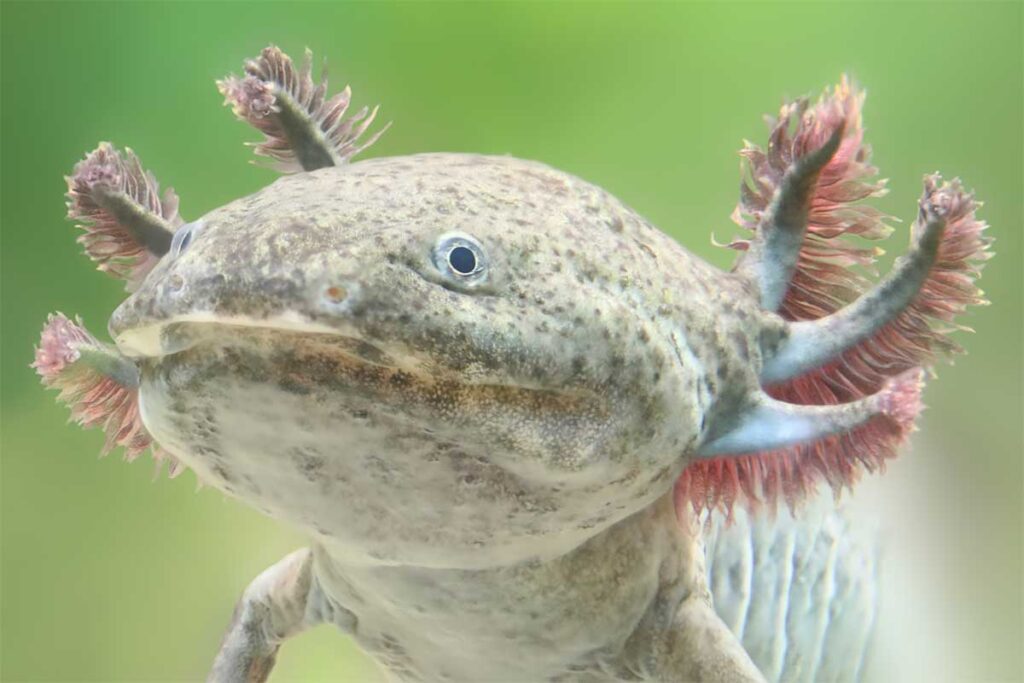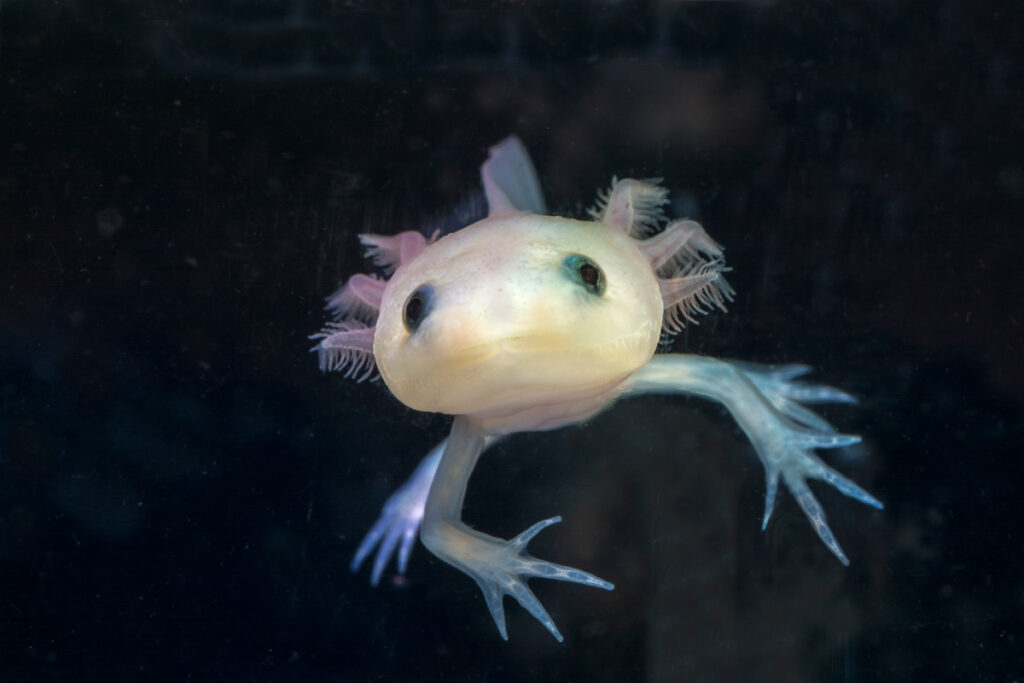Table of Contents
ToggleIntroduction
Are you just getting started with axolotls? Looking to provide them with the finest meals? How often do you give them food? What Do You Feed Axolotls, if any? Daphnia, earthworms, bloodworms, brine shrimp, and other small aquatic crustaceans make a great meal for your axolotl. Lean cuts of meat and chicken are favorites as well. You shouldn’t give them too much live food because that could lead to the unintentional spread of parasites and diseases. This helpful guide teaches about the ideal diet and nutrition for axolotls.
In The Wild, What Do Axolotls Typically Eat?
Axolotls are endemic to the canals and lakes of Mexico’s Xochimilco region, where they consume any tiny creatures they can find. The diet of an axolotl consists of anything it can fit in its mouth, including insects, worms, snails, small crustaceans, crickets, mosquito larvae, smaller salamanders, frog tadpoles, and even smaller fish. The key term here is “swallow,” as axolotls are known to consume their meal whole. Axolotls expand their jaws wide and swallow their prey whole, coupled with water.
Aquarists can easily supply axolotls reared in a home aquarium because the same protein-rich diets are accessible. Axolotls have primitive teeth but don’t chew their food; instead, they utilize them to snap down on whatever they are eating. Next time you feed them, put your hands in the tank to observe how they snag your finger with their teeth. Don’t worry; they can’t bite through human skin even if they try. Axolotls can only consume food that is small enough to pass through their digestive system without causing any obstructions. Impaction, or intestinal obstruction, can be fatal for axolotls if they cannot remove the cause of the impact, such as food that is too large.
How Much And What Kind Of Food To Give Axolotls
Meaty meals such as earthworms (nightcrawlers), black/white worms, live daphnia, live brine shrimp, freeze-dried or frozen feeds (such as bloodworms, brine shrimp), salmon pellets, and other foods are fed to captive-bred axolotls. If you’re concerned about your health, water quality, or the spread of illness, it’s important to weigh the benefits and drawbacks of each dietary option carefully. Some examples of foods that axolotls enjoy are listed below.
Earthworms
Many axolotl keepers use earthworms as a staple diet item because of their high nutrient content. That’s because axolotls enjoy eating earthworms as much as any other preferred food, and for good reason: earthworms are a healthy option that fulfills all of the axolotl’s nutritional needs. Adult axolotls rely heavily on earthworms for nutrition, but whole earthworms can be difficult to swallow, so it’s best to split them into tiny pieces. Another potential problem with earthworms is that they must be washed before being fed to an axolotl.
Daphnia vivipara
Since live daphnia may be too small for people to notice and will not meet the nutritional needs of an adult axolotl, these tiny organisms best serve the dietary needs of newborn axolotls. However, young axolotls enjoy these, so feel free to feed them to your pets. Your axolotl risks contracting any diseases or parasites that may be carried by the live food you feed it. Daphnia can be obtained from reliable sources, or home cultures can be created using a starter kit. Daphnia are cheap, readily available, and potentially beneficial to your aquarium because they consume harmful bacteria.
Breathing Shrimp from the Salt Marsh
Young axolotls do best on a diet of newly-born brine shrimp. They’re cheaper and more readily available than daphnia and can be cultured quickly. If you can’t cook your own, be careful where you buy live brine shrimp because they may be infected. The rapid decomposition of brine shrimp in freshwater might cause chemical imbalances if the dead shrimp are not removed.
Castor or Bryophyta
Black and white worms are a viable replacement for earthworms. They’re cheap to buy or grow in your garden and packed with nutrients. The chemistry of your tank can be disrupted if you don’t clean up any residual worms quickly. They are appropriate for both mature and developing axolotls.
Different Foods
The diet of your axolotl might also include a few different things. The occasional snack of ghost shrimp is one such example.
- Although the nutritional value of frozen bloodworms is lower than that of live meals, axolotls appear to like them equally. The one drawback is that they are messy, so keep that in mind if you feed them to your axolotls.
- Frozen alternatives can be used without access to live brine shrimp cultures; nevertheless, you should still be prepared for some additional cleanup labor.
- Salmon pellets are another great alternative; obtain the soft-sinking variety. Check the label to ensure that these are all natural before feeding them to your axolotl.
What Do Axolotls Eat?

They can clamp down on prey with their fangs and swallow small animals with one swift motion. For example, if you want to feed your axolotls earthworms, you should break the worms into smaller pieces so that the axolotls can consume them. The difficulty is compounded if the meal is too small and gets stuck in the gills. However, preventing choking on overly substantial meals is typically of greater concern.
You can feed your axolotl a bite-sized piece of live food without making a mess using long tweezers. Remove any sharp edges from the tweezers to prevent harm to your axolotl.
A turkey baster is another helpful feeding tool because it can remove any uneaten food from the tank. When leftovers begin decomposing or rotting, they release harmful ammonia levels and must be removed immediately to protect the axis. If you want to ensure the tank is clean, providing your axis with a slightly larger dish they can hover over is a good idea.
Formula For Infant Axolotls
As adults, axolotls’ poor eyesight prevents them from relying on sight alone when hunting for food. However, axolotl hatchlings can only eat live prey because their underdeveloped sense of smell means they must rely on the presence of movement to locate food.
Baby axolotls can only consume live foods since they have little interest in non-living, non-moving meals. Microworms, chopped blackworms that continue to move even after being cut, are a staple diet for young axolotls, along with live daphnia, infant brine shrimp, and other live prey items. The yolks in newly hatched axolotl eggs will provide them with food for the first day or so, but after that, they will need to be fed regularly because they are no longer dependent on their egg yolks for survival.
Safety Of Axolotl Meat: A Remark
Ensure all food added to the tank has been thoroughly inspected for any signs of disease. Parasites and protozoa that are known to infect axolotls can be found in live foods. Such parasites can also be found in living plants. Axolotls do best on a diet of live items, although freeze-dried food can be used as a substitute; just be aware that it lacks the nutritional value of fresh food.
To prevent your axolotls from getting sick from eating contaminated food, look for suppliers who cultivate their products in organic gardens (pesticide-free) or fish-free streams. Some of these delicacies (like brine shrimp) can be easily grown at home using home growth kits.
Conclusion
Although they aren’t picky eaters, axolotls need a balanced diet to thrive. Live foods are the best option, but you need still be careful. Keep in mind that little is more when it comes to axolotl food. It’s easy to give axolotls too much of a good thing because they seem eager to eat. You should always remove leftovers after feeding your fish live food, frozen food, or sinking pellets to keep the water chemistry stable. Inexperienced keepers frequently make this blunder.







